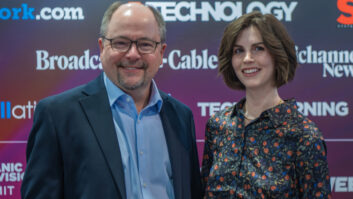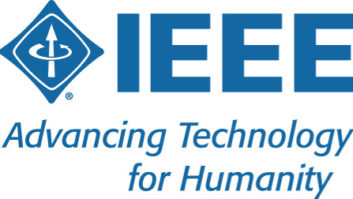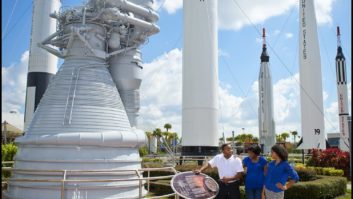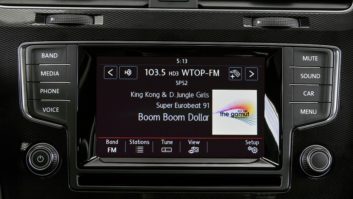
Tom Silliman, right, president of Electronics Research Inc., models the latest in tower climbing safety gear as ERI Director of Installations and Safety Kathy Stieler watches. They were part of a tutorial session at the 2014 IEEE Broadcast Technology Symposium in San Antonio.
Photo credit:
Photos by James O’Neal SAN ANTONIO — Acknowledging that many broadcast owners want to be ecologically sensitive even as they seek to limit operating costs, the IEEE Broadcast Technology Society for the first time included a “green” component in its fall symposium.
Discussions at the October event covered a range of topics, from tower and RF safety to IP infrastructures and audio improvements. Organizers said the event drew 110 attendees, the same as in 2013.
LIGHTING FOR THE FUTURE
A growing concern to broadcasters is reducing the environmental impact from radio and television operations. Much of one day’s proceedings was devoted to this topic, with a round of sessions themed “Green Energy for Broadcast” and featuring presentations exploring economies to be gained by moving to new tower lighting technologies and examining ways for operating AM and FM transmitters more efficiently.
Leslie Kutasi is responsible for broadcast business development at Dialight, which makes visual indicator components. He examined the pros and cons of using incandescent bulbs, xenon strobes and light-emitting diodes to light towers. According to Kuttasi, LEDs don’t carry baggage associated with the other two lighting sources.
“There’s no EMI or ozone generated,” said Kutasi, comparing LEDs to xenon lamps. “They consume only about 5 percent of the electrical power required by incandescents and are completely recyclable, as they contain no hazardous materials.”
He said LEDs offer other advantages in tower lighting. They reduce light pollution by directing their output to the horizon to reach airplanes flying at altitudes near or above towers instead of scattering it to the ground, eliminating the requirement for supplying high-voltage AC to towers. LEDs also are mechanically robust and have long service lives, he said.

Dialight’s Leslie Kutasi examines the pros and cons of using incandescent bulbs, xenon strobes and LEDs to light towers. Kutasi provided an example of the financial savings that could be achieved by replacing incandescent fixtures on a radio tower equipped with a beacon and three sidelights. In the course of a year, assuming a cost of electricity at 8 cents per kilowatt hour, nearly $600 would be required for incandescent lighting, compared to about $13 for LEDs. In addition, due to the long life of LEDs, expenses associated with bulb changing would be eliminated, saving an additional $500 during the year.
Kutasi also pointed to an associated savings in the station’s carbon footprint because of reduced electrical power consumption. “The CO2 saving is 8,905 pounds,” said Kutasi. “That’s almost like taking one car off the road for a year.”
TRANSMITTERS ON A DIET
Cutting transmission costs were next on the program, with GatesAir Manager of Radio Product Development Tim Anderson discussing a way to achieve “significant” savings in connection with the transmission of FM HD Radio, flagging the high peak-to-average power ratio associated in broadcasting digital FM.
Anderson said that with today’s hybrid FM+HD Radio transmission system, as many as 534 OFDM carriers may be generated in modulation of the digital component. In order to provide sufficient headroom for accommodating the peak loads presented in maximum carrier situations, it’s necessary to use a larger RF amplifier than would otherwise be necessary.
“Because of this peak energy, we have to significantly back off the RF amplifier,” said Anderson. “If you want to get a kilowatt out, you have to use a 2.5 kilowatt amplifier. You need to get this high ‘crest factor’ down to make amplification more efficient.”
Anderson showed that with a new modulation algorithm, “PAR2,” the large crest factor associated with earlier techniques could be substantially reduced, thus lowering amplifier peak power requirements and yielding other benefits in the transmission of digital broadcasts.
Greater economies in AM transmitter operation received equal time, with Ben Dawson, managing partner of Hatfield & Dawson Consulting Engineers, delivering a paper on Modulation-Dependent Carrier Control, also called Modulation Dependent Carrier Level technologies, and about which Radio World has written extensively. Dawson used both acronyms in his presentation. Crawford Broadcasting Director of Engineering Cris Alexander, a Radio World contributor, wrote the paper.
Although engineers have worked since the 1930s to reduce AM carrier power requirements, Dawson said, only recently was this really practical in the evolution of broadcasting technology.
“The carrier of an AM signal doesn’t really do anything,” said Dawson. “It’s only real purpose is to be there in order to provide very simple demodulators with a method of turning a complete signal into an easily demodulated signal. The carrier power doesn’t carry any information at all, and therefore is mostly a waste of power.”
He stated that techniques for carrier power reduction were not readily implemented with older AM modulation schemes such as Loy Barton’s invention of high-level Class B modulation, but that present-day transmitters are able to take advantage of MDCL.
“Modern receivers are able to operate very efficiently and with low distortion by using systems that don’t really depend on the carrier to be present to operate correctly,” said Dawson. “MDCC gives you a compromise by reducing, rather than removing, the carrier so that antique demodulators will still operate and both older and newer receivers can receive an acceptable signal.”

GatesAir’s Tim Anderson discusses cutting transmission costs for FM HD. Dawson said that Alaska Public Broadcasting began experimenting with MDCC in 2010, as Radio World has reported. The goal was to provide more economical operation of its transmitters and to reduce requirements for delivering the fuel oil used to generate power at its more remote sites. He said that the FCC was asked for a waiver to allow MDCC, and in response, issued a Public Notice allowing any broadcaster to use this technique.
Dawson noted that Crawford Broadcasting soon implemented MDCC operation at one of its 50 kW installations in California and was able to cut AC power consumption by some 21 percent with no real impact on operations. “As a result of that initial installation, there were essentially no adverse effects reported either by the [listening] audience or by the employees of the station who did the ‘drive testing,’” said Dawson. “And they solicited comment from the listeners as well.”
Dawson said that Crawford had implemented the modulation technique at another of its 50 kW stations with no noticeable impact on reception in low signal areas and no observable effect on IBOC operations or the transmitter’s ability to meet the AM emission mask.
Dawson observed that there are 225 AM stations in the United States licensed to operate with 50 kW daytime power; if MDCC were implemented by all of these stations, some 23.34 gigawatt-hours of electrical power could be saved annually, amounting to about $8,600 per station at an average power cost of 9.8 cents-per- kilowatt-hour.
“That shows you quite thoroughly that the ROI for this sort of thing is very immediate and tangible,” said Dawson.

Cox Media Enterprises’ Huiet Joseph says the company is committed to reducing its energy consumption and carbon commitment by adopting more energy efficient lighting systems, replacing older HVAC control systems and installing fuel cells and photovoltaic power sources at certain broadcast properties.A “GREEN LUNCH”
The “making broadcasting greener” theme was echoed in a keynote address given at the joint Broadcast Technology Society/Association of FCC Engineers luncheon keynote address by Huiet Joseph, senior manager of energy conservation at Cox Enterprises, parent of the Cox Media Group.
Joseph described Cox’s commitment to reducing the organization’s energy consumption and carbon commitment during the next several years by adopting more energy efficient lighting systems, replacing older HVAC control systems and installing fuel cells and photovoltaic power sources at some of its broadcast properties.
“Cox has been into conservation for well over 20 years, with [the initial] efforts focused on lighting and things like that,” said Joseph. “A program called ‘Cox Conserves’ was created in 2007 with a goal of reducing the company’s carbon footprint by 20 percent over a 10-year period. The two main segments of that effort were to reduce our carbon footprint by 10 percent using energy conservation, and 10 percent by using alternative energy sources such as solar.”
In 2007, Cox celebrated the fifth anniversary of the program; in those first years the company spent “over $50 million” on sustainability, according to Joseph. “We successfully implemented 19 solar projects and installed six fuel cells at our properties. We also have water conservation projects. In all, we started about 175 individual energy conservation projects.”
Joseph added: “We’ve also taken efforts to green up our [vehicle] fleet. With the cable systems we have a tremendous number of vehicles that are driven every day so greening up that fleet is very important.”
Next year’s BTS Broadcast Symposium will be held Oct. 14–16 in Orlando, Fla. Visit www.bts.ieee.org for information.
JamesO’Neal is technology editor of TV Technology and a contributor to Radio World. O’Neal is a member of the BTS Administrative Committee, the BTS historian and editor of the BTS quarterly publication.












